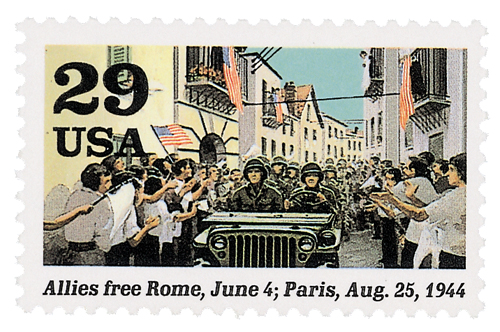
# 4902580 - 1994 Paris & Rome Liberated by Allies PFC
Often called the ultimate philatelic issue, the Fleetwood Proofcard is a distinctive commemorative with an elegantly embossed surface. Each Proofcard bears an original work of art complementing the theme of the stamp and created exclusively for Fleetwood by a leading American artist. Proofcards are often collected on their own, but would also make a beautiful addition to your existing stamp or cover collection.
Allies Free Rome
Although Italy had surrendered on September 3, 1943, Germany was determined to fight for control of the Italian mainland. In a series of head-on assaults the Allies slowly battled their way up the Italian peninsula to Monte Cassino, 75 miles south of Rome. There, held at bay by General Kesselring’s German forces, Allied troops struggled to break through the Gustav (Winter) Line.
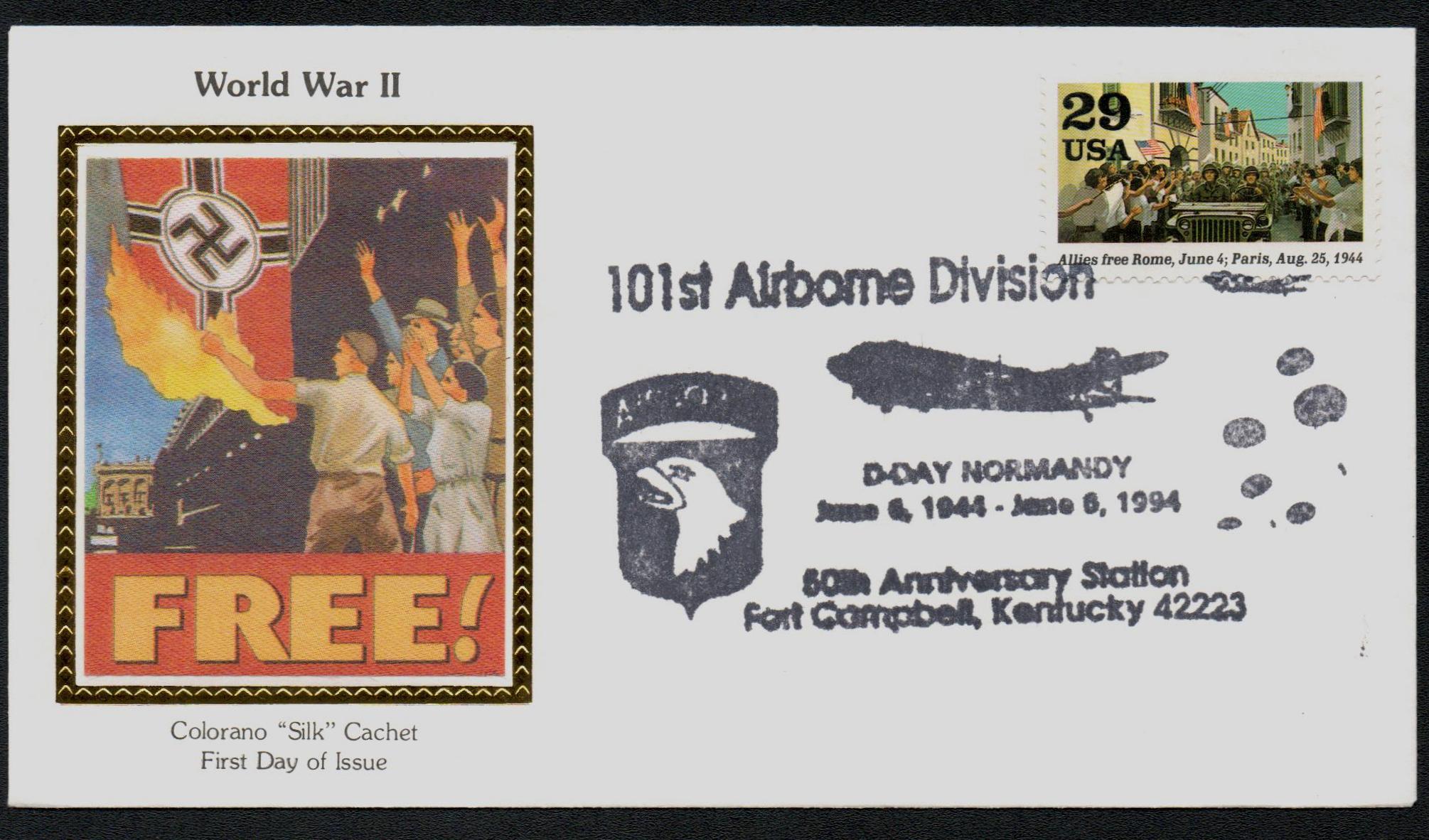
British Prime Minister Winston Churchill then proposed Operation Shingle, which called for landings at Anzio, Italy. With the support of President Franklin Roosevelt, General George Marshall moved forward with the plan.
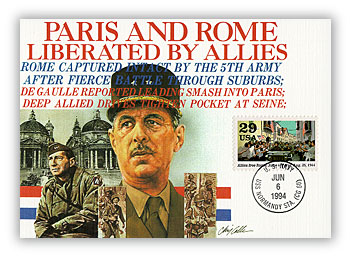
The landing at Anzio occurred on January 22, 1944, and initially met little resistance. By midnight, 36,000 men had come ashore and occupied the beach some two to three miles deep.
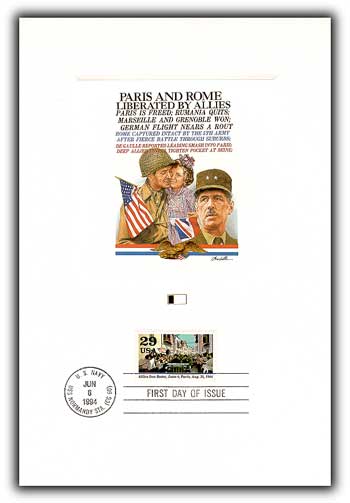
The Germans soon learned of the Allied landing and within two days had a force of 40,000 men in defensive positions ready for battle. The Allies launched their attack on January 30, gaining ground up the Via Anziate, but failing to take the town.
By early February, the German forces outnumbered the Allies over 100,000 to 76,400. The Germans began their attack on the Allies on February 3. After several days of fighting the Germans managed to push the Allied forces back. Another German assault at the end of February ended in a stalemate, and they decided to hold off their offensive operations until spring.
In the meantime, the Allies began planning two operations – Buffalo and Turtle, which would trap the German Tenth Army and allow the Allies to advance toward Rome. The operations were underway by the end of May, with the American forces taking Cisterna on the 25th. The Allies managed to destroy the German line by June 2. The Germans retreated north and the Allies entered Rome on June 4, 1944.
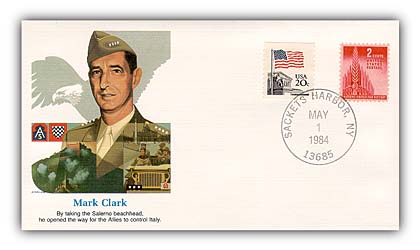
General Mark Clark, who was at the forefront recalled, “There were gay crowds in the streets, many of them waving flags.… Flowers were stuck in the muzzles of the soldiers’ rifles and of the guns on the tanks. Many Romans seemed to be on the verge of hysteria in their enthusiasm for the American troops .…â€Â The fall of Rome marked the final phase of the war. Two days later, Eisenhower’s forces landed in Normandy. And within the next six weeks, American bombers were able to hit targets in eastern Germany for the first time since the war began.
Often called the ultimate philatelic issue, the Fleetwood Proofcard is a distinctive commemorative with an elegantly embossed surface. Each Proofcard bears an original work of art complementing the theme of the stamp and created exclusively for Fleetwood by a leading American artist. Proofcards are often collected on their own, but would also make a beautiful addition to your existing stamp or cover collection.
Allies Free Rome
Although Italy had surrendered on September 3, 1943, Germany was determined to fight for control of the Italian mainland. In a series of head-on assaults the Allies slowly battled their way up the Italian peninsula to Monte Cassino, 75 miles south of Rome. There, held at bay by General Kesselring’s German forces, Allied troops struggled to break through the Gustav (Winter) Line.

British Prime Minister Winston Churchill then proposed Operation Shingle, which called for landings at Anzio, Italy. With the support of President Franklin Roosevelt, General George Marshall moved forward with the plan.

The landing at Anzio occurred on January 22, 1944, and initially met little resistance. By midnight, 36,000 men had come ashore and occupied the beach some two to three miles deep.

The Germans soon learned of the Allied landing and within two days had a force of 40,000 men in defensive positions ready for battle. The Allies launched their attack on January 30, gaining ground up the Via Anziate, but failing to take the town.
By early February, the German forces outnumbered the Allies over 100,000 to 76,400. The Germans began their attack on the Allies on February 3. After several days of fighting the Germans managed to push the Allied forces back. Another German assault at the end of February ended in a stalemate, and they decided to hold off their offensive operations until spring.
In the meantime, the Allies began planning two operations – Buffalo and Turtle, which would trap the German Tenth Army and allow the Allies to advance toward Rome. The operations were underway by the end of May, with the American forces taking Cisterna on the 25th. The Allies managed to destroy the German line by June 2. The Germans retreated north and the Allies entered Rome on June 4, 1944.

General Mark Clark, who was at the forefront recalled, “There were gay crowds in the streets, many of them waving flags.… Flowers were stuck in the muzzles of the soldiers’ rifles and of the guns on the tanks. Many Romans seemed to be on the verge of hysteria in their enthusiasm for the American troops .…â€Â The fall of Rome marked the final phase of the war. Two days later, Eisenhower’s forces landed in Normandy. And within the next six weeks, American bombers were able to hit targets in eastern Germany for the first time since the war began.




